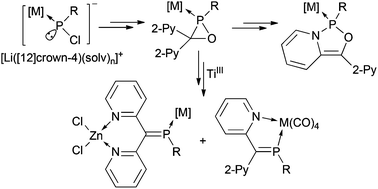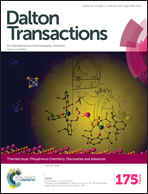Rearrangement and deoxygenation of 3,3-bis(2-pyridyl)oxaphosphirane complexes†
Abstract
The reaction of Li/Cl phosphinidenoid pentacarbonylmetal(0) complexes 2a–c (R = CH(SiMe3)2; M = Cr, Mo, W) with bis(2-pyridyl)ketone led to overcrowded 3,3-bis(2-pyridyl)oxaphosphirane complexes 3a–c. On heating (pyridine at 95 °C or THF at 60 °C) 3c was transformed into complex 4c which had a novel heterobicyclic P-ligand. In the case of the P-Cp* derivative 2d the reaction led to a mixture of oxaphosphirane complex 3d and complex 4d, whereas only the novel heterobicyclic complex 4e was formed in the case of the P-CPh3 substituted complex 2e. Single-crystal X-ray analysis of 4e confirmed the structure of the new ligand as an isomer of the oxaphosphirane which rearranged under loss of aromaticity of one pyridyl substituent. DFT calculations on the P-Me model derivative 3f revealed that, despite the easier C–O bond cleavage in oxaphosphirane complex 3, only the P–C bond cleavage intermediate 6 enables kinetically favoured P–N ring closure to give the bicyclic P-ligand in 4. Preliminary studies demonstrated that complex 3c reacts with an in situ generated Ti(III) complex to give the phosphaalkene complex 10c, the hetero-dinuclear complex 10c·ZnCl2 and the P,N-chelate complex 11c.

- This article is part of the themed collection: Phosphorus Chemistry: Discoveries and Advances

 Please wait while we load your content...
Please wait while we load your content...